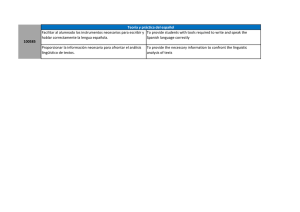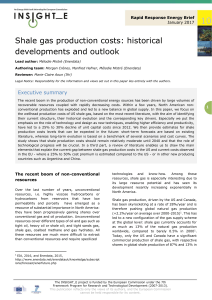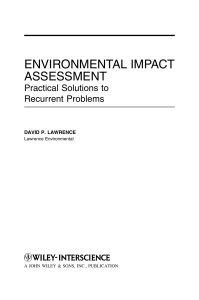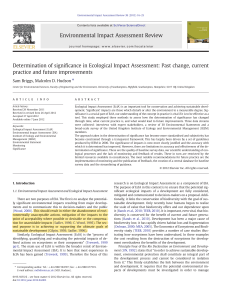Insertar texto aqui
Anuncio
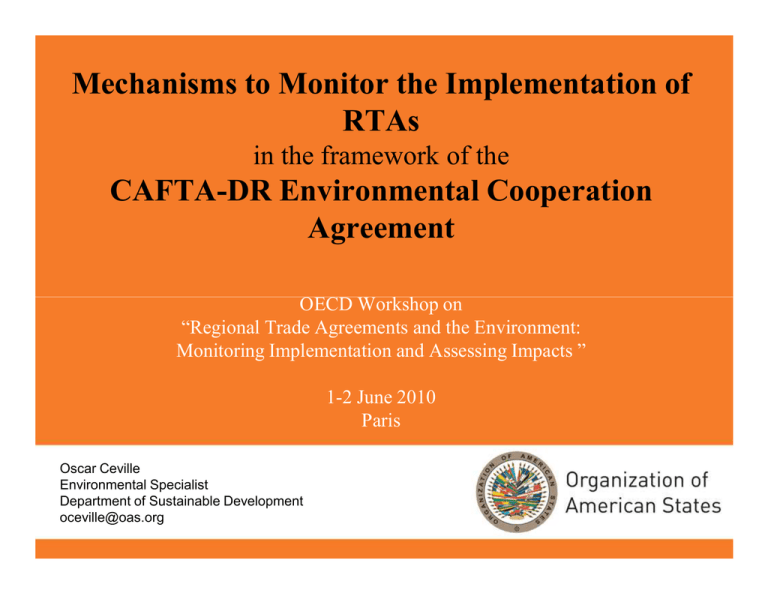
Mechanisms to Monitor the Implementation of RTAs in the framework of the CAFTA-DR Environmental Cooperation Agreement OECD Workshop on “Regional Trade Agreements and the Environment: Monitoring Implementation and Assessing Impacts ” 1-2 June 2010 Paris Oscar Ceville Environmental Specialist Department of Sustainable Development [email protected] Background and Overview § Members: Costa Rica, Dominican Republic, El Salvador, Guatemala, Honduras, Nicaragua and the United States § CAFTA-DR Chapter 17: sets out the Parties’ commitments and undertakings regarding environmental protection. § Environmental Cooperation Agreement (ECA) : the Parties agreed to “cooperate to protect, improve and conserve the environment, including natural resources.” They also came to an understanding that the objective of the ECA was to “establish a framework for such cooperation among the Parties.” Goals of the Environmental Cooperation § Long-term goals: § § § § Compliance with CAFTA-DR Environment Chapter (Chapter 17) obligations. Improved protection and conservation of the environment, including natural resources. Transparency and public participation in environmental decision-making. An improved culture of environmental protection and compliance with environmental laws through, among other things, the promotion of economic opportunities, voluntary measures to enhance environmental performance, and job creation. Implementation of Cooperation Activities Role of the OAS: Support the ECC in evaluating if and how cooperative activities funded under the Environmental Cooperation Agreement (ECA) are contributing towards the achievement of the long term goals established by the Parties. Efforts are not meant to verify compliance with the obligations but the impact of the cooperation and achievement of long term environmental goals. Monitoring and Evaluation § No standard methodology to conduct an assessment of this type of cooperation. § Few regional assessments of environmental cooperation in the context of FTAs. § Extremely challenging to set up a harmonized M&E process and system. Monitoring and Evaluation § Work Plan: To facilitate the implementation of the Work Plan, the POCs decided to structure activities under five themes: A. Institutional Strengthening B. Biodiversity and Conservation C. Market-based Conservation D. Improved Private Sector Environmental Performance § Road Map: Developed based on the need to identify measurable outcomes and outputs under the CAFTA-DR program areas. Monitoring and Evaluation § First Evaluation Report - October 2009 Qualitative evaluation using criteria: Relevance Efficiency Effectiveness Sustainability üParticipation üFocused on observations üTriangulation üObtaining üRevision üField of key stakeholders of information sources reliable results of information visits and interviews üSurveys Monitoring and Evaluation § Second Evaluation Report – November 2010 Quantitative evaluation: Performance Measurement Framework (PMF) ü ü ü ü ü ü ü ü Road Map àPMF (LFA?) Baseline data/information Develop output indicators: » F indicators » Indicators from Quarterly Reports (implementing agencies) » Other Review output indicators Develop outcome indicators Review Q reports to update PMF Prepare regional PMF Determine results of the cooperation program at regional level Monitoring and Evaluation PRODUCTOS INDICADORES FUENTES DE VERIFICACIÓN (DATOS) LINEA DE BASE META RESPONSABILIDAD / FRECUENCIA Meta A Fortalecer a las instituciones para la aplicación y el cumplimiento efectivo de la legislación ambiental Propósito principal: Fortalecer a las instituciones ambientales, leyes y políticas, promover la aplicación y el cumplimiento efectivo de esas leyes y políticas, así como la aplicación efectiva de los Acuerdos Multilaterales de Medio Ambientales , y promover la participación de la soci edad civil para garantizar el cumplimiento de las obligaciones de los TLC Sub Meta A.1 Fortalecimiento de la legislación, reglamentaciones y políticas ambientales Resultado A1) 1. Fortalecimiento de las capacidades para evaluar EIA A1) 1.1 Proceso de revisión de las • evaluaciones de impacto ambiental fortalecido. • • • • • • 1.1.1 # de técnicos/ profesionales Dirección General de Gestión capacitados en temas de EIA, Ambiental y Recursos incluyendo en los principios para la Naturales-MARN revisión de EIA 1.1.2 # de guías técnicas sectoriales elaboradas (, minería, energía) 1.1.3 Existencia de un sistema de información ambiental para EIA funcionando 1.1.4 # y tipo instrumentos para la revisión de EIA 1.1.5 Existencia de categorías para actividades/obras/ proyectos que requieren EIA según la lista de artículo 21 1.1.6 # de empresarios sensibilizados sobre los instrumentos de EIA 1.1.7 # de guías adoptadas por los siguientes sectores: minero, turismo, agrícola, industrial, 1.1.1 1.1.2 1.1.3 1.1.4 1.1.5 1.1.6 0 0 N/A N/A 1.1.1 100 (en la región, de una serie de 3 cursos en temas de EIA) 1.1.2 2 (en la región) 1.1.3 0 (2 en la región) 1.1.4 0 (2 en la región) 1.1.5 1.1.6 ABT 1.1.1, 1.1.2, 1.1.3 1.1.7, CCAD (1.1.2-1.1.5) ELE (1.1.1, 1.1.2, 1.1.3, 1.1.4) EPA 1.1.1, 1.1.2 Provided logistical support for 1.1.1. EPA provided the training. ELE has additional training responsibilities but only the work on the interactive CD ROM is linked to the Principles of EIA Review training course. GRACIAS



